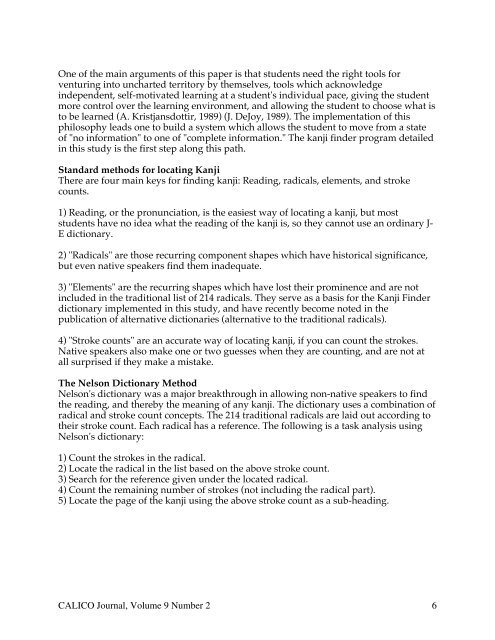Kanji Retrieval by Recursive Location of Elements Using HyperCard
Kanji Retrieval by Recursive Location of Elements Using HyperCard
Kanji Retrieval by Recursive Location of Elements Using HyperCard
Create successful ePaper yourself
Turn your PDF publications into a flip-book with our unique Google optimized e-Paper software.
One <strong>of</strong> the main arguments <strong>of</strong> this paper is that students need the right tools for<br />
venturing into uncharted territory <strong>by</strong> themselves, tools which acknowledge<br />
independent, self-motivated learning at a student's individual pace, giving the student<br />
more control over the learning environment, and allowing the student to choose what is<br />
to be learned (A. Kristjansdottir, 1989) (J. DeJoy, 1989). The implementation <strong>of</strong> this<br />
philosophy leads one to build a system which allows the student to move from a state<br />
<strong>of</strong> "no information" to one <strong>of</strong> "complete information." The kanji finder program detailed<br />
in this study is the first step along this path.<br />
Standard methods for locating <strong>Kanji</strong><br />
There are four main keys for finding kanji: Reading, radicals, elements, and stroke<br />
counts.<br />
1) Reading, or the pronunciation, is the easiest way <strong>of</strong> locating a kanji, but most<br />
students have no idea what the reading <strong>of</strong> the kanji is, so they cannot use an ordinary J-<br />
E dictionary.<br />
2) "Radicals" are those recurring component shapes which have historical significance,<br />
but even native speakers find them inadequate.<br />
3) "<strong>Elements</strong>" are the recurring shapes which have lost their prominence and are not<br />
included in the traditional list <strong>of</strong> 214 radicals. They serve as a basis for the <strong>Kanji</strong> Finder<br />
dictionary implemented in this study, and have recently become noted in the<br />
publication <strong>of</strong> alternative dictionaries (alternative to the traditional radicals).<br />
4) "Stroke counts" are an accurate way <strong>of</strong> locating kanji, if you can count the strokes.<br />
Native speakers also make one or two guesses when they are counting, and are not at<br />
all surprised if they make a mistake.<br />
The Nelson Dictionary Method<br />
Nelson's dictionary was a major breakthrough in allowing non-native speakers to find<br />
the reading, and there<strong>by</strong> the meaning <strong>of</strong> any kanji. The dictionary uses a combination <strong>of</strong><br />
radical and stroke count concepts. The 214 traditional radicals are laid out according to<br />
their stroke count. Each radical has a reference. The following is a task analysis using<br />
Nelson's dictionary:<br />
1) Count the strokes in the radical.<br />
2) Locate the radical in the list based on the above stroke count.<br />
3) Search for the reference given under the located radical.<br />
4) Count the remaining number <strong>of</strong> strokes (not including the radical part).<br />
5) Locate the page <strong>of</strong> the kanji using the above stroke count as a sub-heading.<br />
CALICO Journal, Volume 9 Number 2 6
















